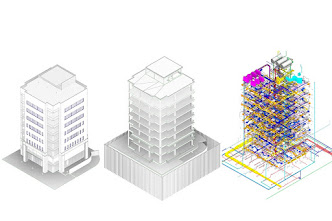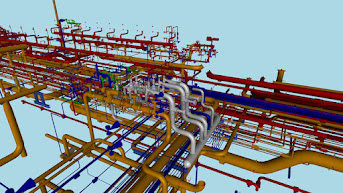Exploring the Art of BIM Fabrication Services.
As a BIM designer at Silicon Valley, I've seen firsthand the power of digital fabrication to transform the construction industry. By using BIM models to create precise, accurate, and detailed fabrication instructions, we can reduce waste, improve quality, and speed up construction schedules.
In this blog post on Silicon Valley, I'll explore the art of BIM Fabrication Services and discuss the benefits of this innovative construction approach. I'll also share some of my own experiences working with BIM fabrication and I'll offer some tips for getting started with this exciting new technology.
What is BIM fabrication?
BIM fabrication is the process of using Building Information Modeling (BIM) data to create precise, accurate, and detailed fabrication instructions. These instructions can be used to manufacture building components off-site, which can then be assembled on-site to create a complete building.
BIM fabrication offers many benefits over traditional construction methods. First, it can help to reduce waste by ensuring that only the necessary materials are used. Second, it can improve quality by ensuring that all components are manufactured to the same exacting standards. Third, it can speed up construction schedules by allowing components to be manufactured off-site and then delivered to the construction site ready to be assembled.
Why use BIM fabrication?
There are many reasons why you might want to use BIM fabrication for your next project. Here are just a few:
- Reduce waste: BIM fabrication can help you to reduce waste by ensuring that only the necessary materials are used. This can save you money and help to protect the environment.
- Improve quality: BIM fabrication can help you to improve quality by ensuring that all components are manufactured to the same exacting standards. This can reduce the risk of defects and improve the overall performance of your building.
- Speed up construction schedules: BIM fabrication can help you to speed up construction schedules by allowing components to be manufactured off-site and then delivered to the construction site ready to be assembled. This can save you time and money.
- Increase flexibility: BIM fabrication can increase your flexibility by allowing you to make changes to your design at the last minute without having to start over. This can be especially helpful if you're working on a complex or customized project.
How to get started with BIM fabrication:
If you're interested in getting started with BIM fabrication, there are a few things you need to do. First, you need to create a BIM model for your project. This model should be as detailed as possible so that the fabrication instructions can be as accurate as possible.
Once you have a BIM model, you need to find a fabricator who is familiar with BIM fabrication. Some fabricators offer BIM fabrication services, so you should be able to find one who is a good fit for your project.
Finally, you need to work with the fabricator to create the fabrication instructions. These instructions should be detailed and accurate, and they should be based on the BIM model.
My own experiences with BIM fabrication:
I've had the opportunity to work with BIM fabrication on some projects, and I've been very impressed with the results. In one project, we used BIM fabrication to create a complex steel structure. The BIM model allowed us to identify any potential clashes between the different components of the structure, and it also allowed us to create detailed fabrication instructions that were used to manufacture the structure off-site. The result was a structure that was built to the exacting standards of the project, and it was completed on time and budget.
In another project, we used BIM fabrication to create a series of prefabricated concrete panels. The BIM model allowed us to optimize the design of the panels, and it also allowed us to create detailed fabrication instructions that were used to manufacture the panels off-site. The result was a series of panels that were of the highest quality, and they were installed on-site in a matter of days.
Tips for getting started with BIM fabrication:
If you're interested in getting started with BIM fabrication, here are a few tips:
- Start by creating a detailed BIM model of your project. This model should be as accurate as possible so that the fabrication instructions can be as accurate as possible.
- Find a fabricator who is familiar with BIM fabrication. Several fabricators offer BIM fabrication services, so you should be able to find one who is a good fit for your project.
- Work with the fabricator to create the fabrication instructions. These instructions should be detailed and accurate, and they should be based on the BIM model.
- Be prepared to invest in the necessary software and training. BIM fabrication requires the use of specialized software, and it's important to have the necessary training to use this software effectively.
The future of BIM fabrication:
BIM fabrication is a rapidly growing field, and I believe that it has the potential to revolutionize the construction industry. As the technology continues to develop, I believe that we'll see even more benefits from BIM fabrication, such as even greater reductions in waste and even higher levels of quality.
If you're looking for a way to improve your next construction project, I encourage you to consider using BIM fabrication. It's a powerful new technology that can help you to achieve your project goals.
The future of BIM fabrication:
BIM fabrication is a rapidly growing field, and I believe that it has the potential to revolutionize the construction industry. As the technology continues to develop, I believe that we'll see even more benefits from BIM fabrication, such as even greater reductions in waste and even higher levels of quality.
One of the most promising areas of development in BIM fabrication is the use of 3D printing. 3D printing allows us to create complex and intricate components that would be difficult or impossible to manufacture using traditional methods. This opens up new possibilities for the design and construction of buildings, and it could lead to even greater reductions in waste and improved quality.
Another area of development is the use of BIM fabrication in modular construction. Modular construction is a method of construction where entire building modules are manufactured off-site and then assembled on-site. This method of construction is becoming increasingly popular, and it is well-suited for BIM fabrication.
The use of BIM fabrication in modular construction can lead to many benefits, including:
- Reduced construction time: Modular buildings can be assembled much faster than traditional buildings, which can save time and money.
- Improved quality: Modular buildings are typically of higher quality than traditional buildings because they are manufactured in a controlled environment.
- Increased flexibility: Modular buildings can be easily customized to meet the specific needs of the client.
I believe that BIM fabrication has the potential to revolutionize the construction industry. As technology continues to develop, we'll see even more benefits from BIM fabrication, and it will become an increasingly common method of construction.
Conclusion:
BIM fabrication is a powerful new technology that can help you to reduce waste, improve quality, and speed up construction schedules. If you're looking for a way to improve your next construction project, I encourage you to consider using BIM fabrication.
BIM fabrication is a powerful new technology that has the potential to revolutionize the construction industry. By using BIM models to create precise, accurate, and detailed fabrication instructions, we can reduce waste, improve quality, and speed up construction schedules.
As technology continues to develop, I believe that we'll see even more benefits from BIM fabrication. For example, I believe that we'll see the development of new materials and manufacturing processes that will allow us to create even more complex and intricate components. I also believe that we'll see the development of new software tools that will make it easier to create and manage BIM models.
I believe that BIM fabrication has the potential to make construction projects more efficient, more sustainable, and more affordable. If you're looking for a way to improve your next construction project, I encourage you to consider using BIM fabrication.
Thank you for reading!
Here are some additional thoughts on the future of BIM fabrication:
- I believe that BIM fabrication will become increasingly common in the construction industry. As the technology becomes more affordable and accessible, more and more builders will adopt it.
- I believe that BIM fabrication will lead to the development of new and innovative construction methods. For example, I believe that we'll see the development of new modular construction techniques that will allow us to build buildings more quickly and efficiently.
- I believe that BIM fabrication will have a positive impact on the environment. By reducing waste and improving efficiency, BIM fabrication can help to reduce the environmental impact of construction projects.
I'm excited to see how BIM fabrication will develop in the years to come. I believe that it has the potential to make a real difference in the construction industry and the world.
Also Check Our Latest blog on - Navigating the Challenges of BIM Coordination: Tips and Best Practiceshttps://www.linkedin.com/pulse/navigating-challenges-bim-coordination-tips



Comments
Post a Comment